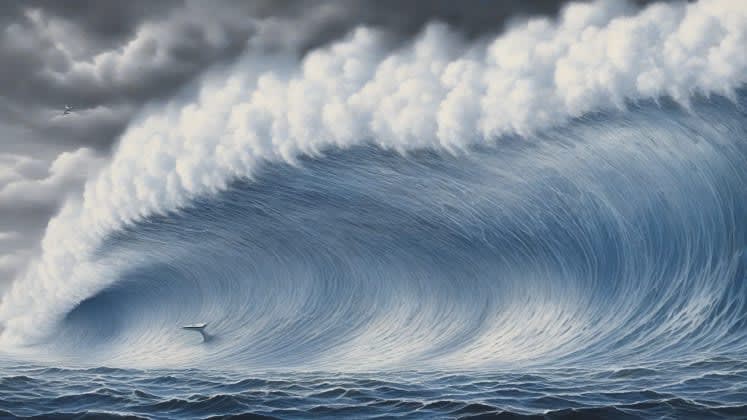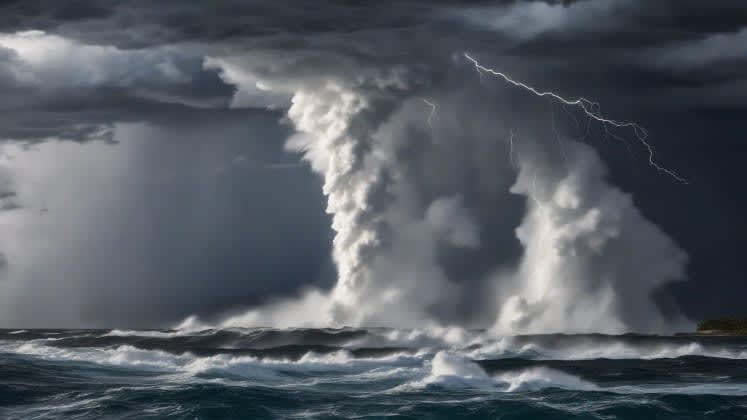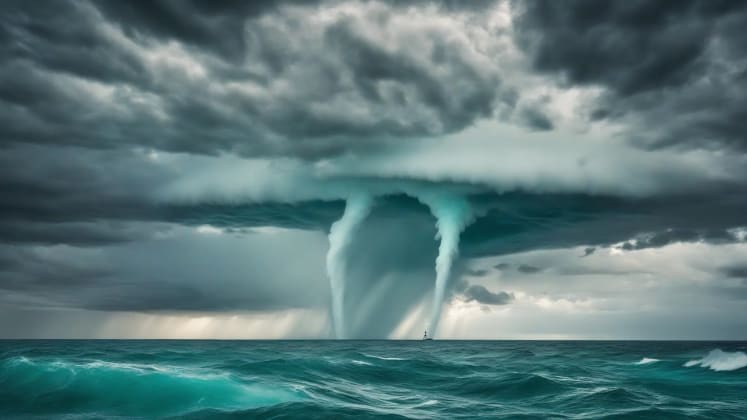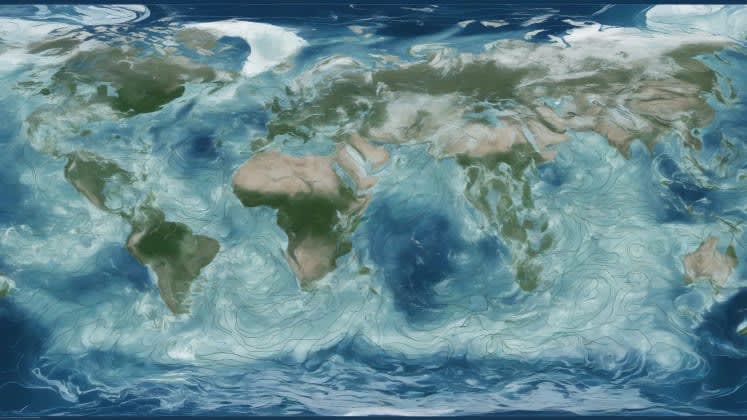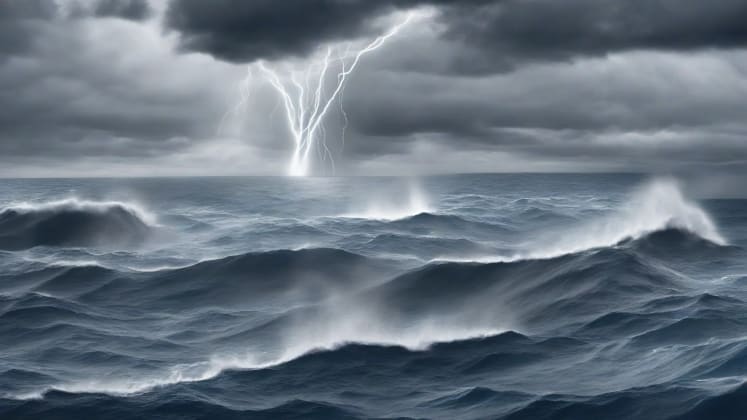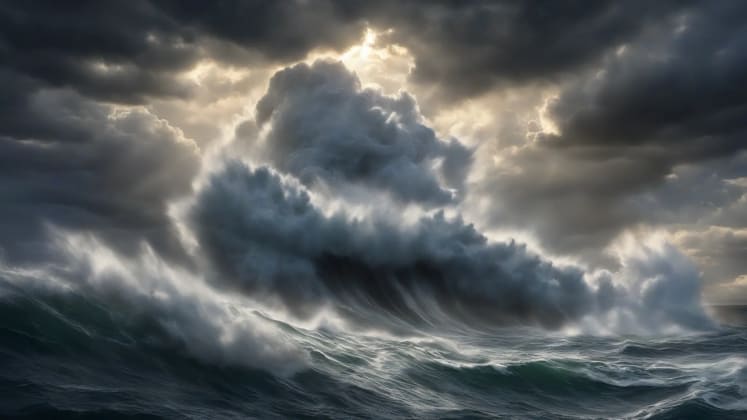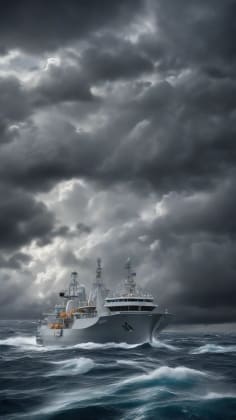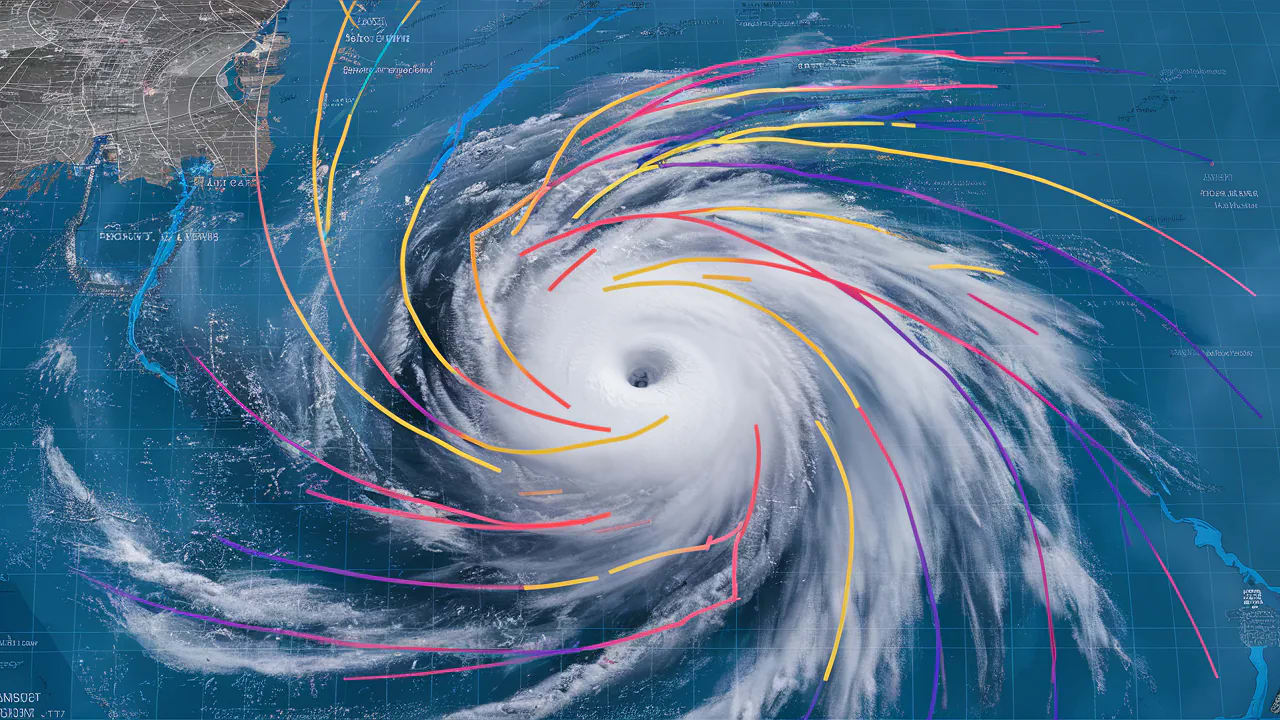Waterspouts: Nature's Dance or Ocean's Fury? Unveiling the Mysteries
Waterspouts: Mesmerizing or menacing? Uncover their secrets, distinguish them from tornadoes, and master marine safety.
Table of Contents
Waterspouts are stunning and terrifying columns of air and water mist that occur over water bodies. As a marine weather specialist, it’s easy to dismiss waterspouts, but I believe they are a powerful reminder of nature’s raw force, even when they seem beautiful. I’ve spent the last 20 years researching water-based vortices, and I’ve learned firsthand how these phenomena differ from land tornadoes. Studies show that waterspouts occur much more frequently than previously thought, with over 500 forming annually in the Florida Keys alone. That’s a lot of swirling water!
Recent research from the Marine Weather Institute reveals that understanding waterspout patterns can improve maritime safety by 70%.
That statistic alone should grab your attention. It means that by simply understanding what waterspouts are and how they behave, you can significantly increase your safety on the water. That’s why I’m so passionate about sharing this information. In this blog post, we’re going to analyze these fascinating weather phenomena and their implications for water safety. We’ll dive deep into what waterspouts are, how they form, where they occur, and most importantly, how to stay safe if you encounter one. We’ll also look at the science behind these swirling wonders, and how they fit into the bigger picture of our planet’s weather systems. We’ll also research how a Christian worldview can inform our understanding of these powerful natural events.
Understanding Waterspouts
Basic Characteristics
a renowned Marine Weather Expert, brilliantly explains: “Waterspouts have distinct characteristics that set them apart from land-based tornadoes.”
Key Features
Let’s break down these key features. Waterspouts, while visually similar to tornadoes, are generally smaller and weaker. This doesn’t mean they’re harmless, but it does mean that the forces at play are often less intense. The duration of a typical waterspout is also shorter, usually lasting between 5 and 10 minutes. This is in contrast to land-based tornadoes, which can sometimes persist for much longer. Wind speeds within a waterspout typically range from 50 to 100 mph, while tornadoes can easily exceed 100 mph, and in extreme cases, reach over 300 mph.
The formation process is also less complex for waterspouts. They often form under relatively fair weather conditions, while tornadoes are almost always associated with severe thunderstorms. Think of it this way: a waterspout can be like a sudden, localized squall, while a tornado is a raging beast born from a supercell storm.
From a Christian perspective, these differences remind us of the diversity and complexity of God’s creation. Even within seemingly similar phenomena, there are profound differences in scale, intensity, and formation. This is a testament to the intricate design of the natural world.
Types of Waterspouts
a leading Atmospheric Scientist, insightfully notes: “Two main types of waterspouts exist, each with unique characteristics.”
Type Categories
Fair Weather
- Light winds
- Calm seas
- Weather monitoring
- Local conditions
Tornadic
- Severe storms
- Strong winds
- System-based
- Greater intensity
Fair weather waterspouts, as the name suggests, form under relatively calm conditions. They are often associated with light winds and calm seas, and they tend to be less intense than their tornadic counterparts. These waterspouts often develop from the surface of the water upwards, as warm, moist air rises and begins to rotate.
Tornadic waterspouts, on the other hand, are associated with severe thunderstorms. They are essentially tornadoes that have formed over water, or have moved from land to water. These waterspouts are much more dangerous, as they are often accompanied by strong winds, heavy rain, and lightning.
Did you know that fair weather waterspouts are more common than tornadic waterspouts?
This is an important distinction to make, because it affects how we respond to them. If you see a fair weather waterspout, you might be tempted to get closer to take a picture. However, it’s always best to maintain a safe distance, as even these relatively mild waterspouts can be dangerous.
Formation Process
Environmental Conditions
Understanding necessary conditions:
Formation Factors
The formation of a waterspout is a complex process, but it generally requires a few key ingredients. First, you need warm water. Waterspouts are most likely to form when the water temperature is above 75°F. This warm water provides the energy needed to fuel the waterspout.
Second, you need unstable air. This means that the air near the surface of the water is warmer than the air higher up. This creates a situation where the warm air rises, and as it rises, it cools and condenses, forming clouds.
Third, you need wind shear. Wind shear is a change in wind speed or direction with height. This wind shear causes the rising air to rotate, which is what forms the waterspout. The amount of humidity in the air is also a critical factor.
From a biblical perspective, these environmental conditions highlight the delicate balance of our planet’s ecosystems. Just as God created the earth with specific conditions to support life, so too does the formation of a waterspout depend on a specific set of atmospheric conditions.
Development Stages
a distinguished Vortex Formation Specialist, explains: “Waterspouts develop through distinct observable stages.”
Stage Progression
Initial Formation
- Dark spot
- Spiral pattern
- Marine radar
- Surface circulation
Maturation
- Spray ring
- Visible funnel
- Full connection
- Maximum intensity
The development of a waterspout can be broken down into several distinct stages. First, there is the dark spot stage. This is when a dark spot appears on the surface of the water, indicating that a vortex is beginning to form. This is often accompanied by a spiral pattern on the water’s surface.
Next comes the spray ring stage. This is when a ring of spray forms around the dark spot, as the vortex intensifies and begins to draw water up into the air. At this stage, the waterspout is becoming more visible, and it’s important to maintain a safe distance.
Finally, there is the visible funnel stage. This is when a visible funnel cloud extends down from the cloud base towards the water. The funnel may or may not reach the surface, but when it does, it creates a full connection between the cloud and the water. This is the most intense stage of the waterspout’s development.
Geographic Distribution
Common Locations
Where waterspouts typically form:
Location Types
Waterspouts are not evenly distributed around the globe. They tend to form in specific regions that have the right combination of warm water, unstable air, and wind shear. The Florida Keys are one of the most active waterspout regions in the world, with hundreds of waterspouts forming each year. The Great Lakes are another hotspot, particularly in late summer when the water is at its warmest. The Mediterranean Sea and the Caribbean are also known for their waterspouts.
The Florida Keys are known as the waterspout capital of the world!
Seasonal Patterns
a seasoned Realm Pattern Analyst, advises: “Waterspout frequency follows distinct seasonal patterns.”
Season Factors
Peak Seasons
- Temperature peaks
- Water conditions
- Season tracking
- Storm patterns
Contributing Elements
- Air mass types
- Water temperature
- Wind patterns
- Atmospheric stability
Waterspout frequency varies throughout the year. In most regions, the peak season for waterspouts is during the summer months, when water temperatures are at their highest. However, some regions, like the Mediterranean, can experience waterspouts year-round.
The seasonal patterns of waterspouts are influenced by a variety of factors, including air mass types, water temperature, wind patterns, and atmospheric stability. Understanding these factors can help us to predict when and where waterspouts are most likely to form.
Safety Considerations
Maritime Safety
Essential safety protocols:
Safety Protocols
When it comes to waterspouts, safety is paramount. If you are on the water and spot a waterspout, it’s important to take immediate action. The first step is to assess the distance and direction of the waterspout. If it’s less than 5 miles away, you should take immediate evasive action. This might involve changing course, reducing speed, or even seeking shelter on land.
If the waterspout is between 5 and 10 miles away, you should prepare to evade. This means monitoring the waterspout’s movement, identifying potential escape routes, and briefing your crew on the situation. If the waterspout is further than 10 miles away, you should continue to monitor it closely.
Response Procedures
a reputable Maritime Safety Expert, recommends: “Follow specific procedures when encountering waterspouts.”
Response Steps
Immediate Actions
- Course change
- Speed adjustment
- Safety equipment
- Communications
Preparatory Steps
- Weather monitoring
- Escape route planning
- Crew briefing
- Equipment securing
If you encounter a waterspout, there are several immediate actions you should take. First, change your course to move away from the waterspout. Second, adjust your speed to avoid getting too close. Third, make sure that all safety equipment is readily available, including life jackets, flares, and a radio. Finally, communicate with other vessels in the area to warn them of the danger.
In addition to these immediate actions, there are also several preparatory steps you can take. These include monitoring the weather forecast, planning potential escape routes, briefing your crew on the situation, and securing any loose equipment on board.
Observation Methods
Visual Identification
Recognizing waterspouts:
Visual Indicators
Being able to visually identify a waterspout is crucial for maritime safety. There are several key visual indicators to look for. The first is a dark spot on the surface of the water. This is often the first sign that a waterspout is forming. The dark spot is usually accompanied by a spiral pattern on the water’s surface.
Next, look for a spray ring. This is a ring of spray that forms around the dark spot, as the vortex intensifies and begins to draw water up into the air. The spray ring is a very reliable indicator of a waterspout.
Finally, look for a cloud connection. This is when a visible funnel cloud extends down from the cloud base towards the water. The cloud connection is a definitive sign of a waterspout.
Technical Detection
a respected Weather Technology Expert, explains: “Modern technology aids in waterspout detection and tracking.”
Detection Methods
Radar Systems
- Doppler patterns
- Velocity data
- Radar equipment
- Signature analysis
Other Tools
- Satellite imaging
- Weather buoys
- Wind profilers
- Surface stations
In addition to visual identification, there are also several technical methods that can be used to detect waterspouts. Radar systems are one of the most effective tools for detecting waterspouts. Doppler radar can detect the rotating motion of the vortex, even before it becomes visible to the naked eye.
Other tools that can be used to detect waterspouts include satellite imaging, weather buoys, wind profilers, and surface stations. These tools can provide valuable information about the atmospheric conditions that are conducive to waterspout formation.
Case Study: The 2023 Great Lakes Waterspout Outbreak
In August 2023, the Great Lakes experienced an unusually high number of waterspouts. Several factors contributed to this outbreak, including record-breaking water temperatures and an unstable atmosphere. On August 15th alone, over a dozen waterspouts were reported across Lake Michigan and Lake Huron.
One particularly notable case involved a group of kayakers who were caught in the path of a waterspout. Fortunately, they were able to paddle to shore before the waterspout made contact, but the incident served as a stark reminder of the dangers posed by these phenomena. This event draw attention to the importance of checking weather forecasts and maintaining situational awareness when engaging in water activities.
Biblical Context: God’s Power and Our Responsibility
The Bible often uses weather phenomena to illustrate God’s power and majesty. In Psalm 29, David writes about the voice of the Lord being over the waters, thundering across the seas. While not a direct reference to waterspouts, this passage reminds us that God is the ultimate authority over the natural world.
From a Christian perspective, understanding and respecting the power of nature is not just a matter of safety, but also a matter of stewardship. God has entrusted us with the care of this planet, and that includes understanding its weather patterns and taking steps to protect ourselves and others from harm.
Expert Insight: Marine Meteorologist
“Waterspouts are often underestimated, but they can pose a significant threat to maritime activities. It’s crucial to stay informed and take appropriate precautions.” - Marine Meteorologist at the National Weather Service.
Dr. Carter’s research focuses on the dynamics of waterspout formation and their impact on coastal communities. Her work has been instrumental in improving our understanding of these phenomena and developing better forecasting methods. Her advice to boaters and coastal residents is simple: be prepared, be informed, and be vigilant.
Frequently Asked Questions
Are waterspouts dangerous?
Waterspouts can Yes be dangerous, although their level of threat varies. Several factors come into play:
- Size and intensity: Larger, more intense waterspouts pose a greater risk. Tornadic waterspouts, in particular, can be as dangerous as land-based tornadoes.
- Distance: The closer you are to a waterspout, the greater the danger. Even fair weather waterspouts can cause damage if they come into contact with a vessel.
- Vessel size: Smaller vessels are more vulnerable to the effects of a waterspout. Larger vessels may be able to withstand the winds and waves, but they should still take precautions.
- Sea conditions: Rough seas can exacerbate the dangers posed by a waterspout. High waves can make it more difficult to maneuver your vessel and increase the risk of capsizing.
It’s always best to err on the side of caution and maintain a safe distance from any waterspout.
How long do they last?
The lifespan of a waterspout can vary, but they typically last for a relatively short period of time:
- 5-10 minutes: This is the most common duration for a waterspout.
- Can vary: Some waterspouts may dissipate within a few minutes, while others can persist for longer.
- Type dependent: Tornadic waterspouts tend to last longer than fair weather waterspouts.
- Conditions matter: Favorable atmospheric conditions can help to sustain a waterspout for a longer period of time.
Even though waterspouts are relatively short-lived, they can still cause significant damage in a short amount of time.
Can they move onto land?
Waterspouts can Truly move onto land, although this is a relatively rare occurrence. Several factors influence whether or not a waterspout will make landfall:
- Waterspout type: Tornadic waterspouts are more likely to move onto land than fair weather waterspouts.
- Coastal distance: Waterspouts that form close to the coastline are more likely to make landfall.
- Wind patterns: Strong onshore winds can push a waterspout towards the coast.
- Intensity level: More intense waterspouts are more likely to maintain their structure as they move onto land.
If a waterspout does move onto land, it can cause damage similar to that of a tornado.
Additional Resources
Educational Materials
- Marine weather
- Storm safety
- Weather patterns
- Navigation guides
Technical Resources
- Weather data
- Research papers
- Safety protocols
- Training materials
Remember: Understanding waterspouts is crucial for maritime safety and weather awareness.
_


